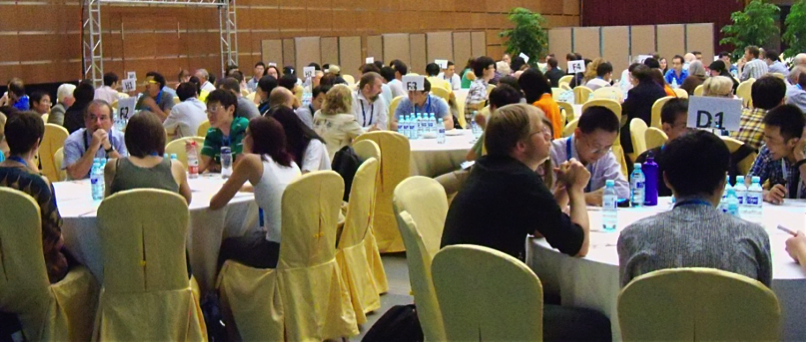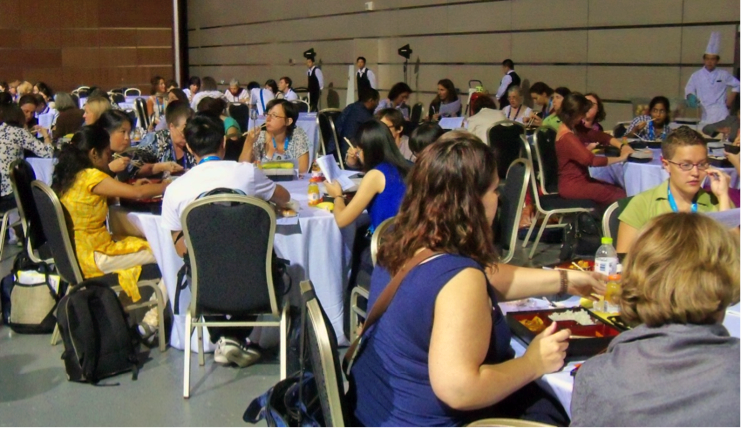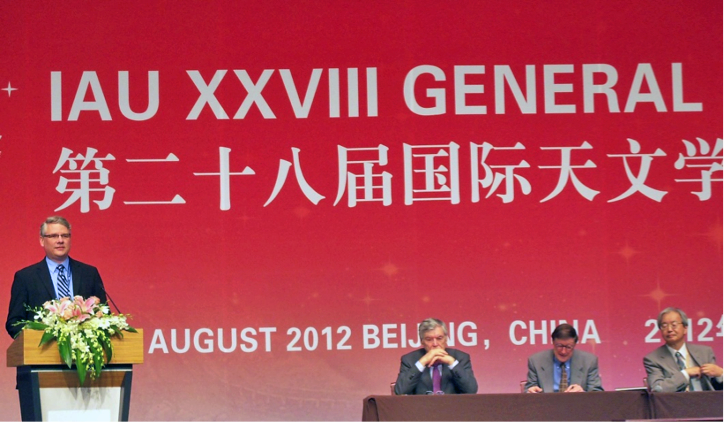Report on the 2012 IAU XXVIII General Assembly
Edward Guinan Villanova University
The International Astronomical Union (IAU) General Assembly (GA) takes place every three years and lasts for 10 days. The following report on IAU XXVIII GA, held 20-31 August 2012 in Beijing, China, was prepared by Edward Guinan, chair of the U.S. National Committee (USNC) for the IAU, and Kathie Bailey-Mathae, director of the Board on International Scientific Organizations (BISO).
I. Overview of the General Assembly
The 28th IAU General Assembly (GA) was held in Beijing, China, 20-31 August 2012. The GA was held in the China National Convention Center (CNCC), located on the 2008 Olympics site.
Currently, the IAU consists of 10,900 individual members from 93 countries. Seventy-three countries are now national members, with the Democratic People's Republic of Korea, Ethiopia, and Kazakhstan joining the IAU at the GA. The GA was attended by over 2,700 astronomers and guests from over 55 different countries. The United States was well represented at the meeting with about 440 astronomers and guests attending. About 100 U.S. astronomers were supported by travel grants from the NSF (arranged through the AAS). Many important papers and talks were given by astronomers from the United States. Of particular note, U.S. astronomer (and USNC member) Bob Williams served as the President of the IAU from August 2009 through the end of the GA. Williams officiated at many of the GA functions and events.
The scientific program of the GA was diverse and attractive with an expanded schedule of sessions and talks. There were four Invited Discourses (IDs) held at plenary sessions. One of these IDs, "Supernovae, the Accelerating Cosmos, and Dark Energy," was given by U.S. astronomer and recent Nobel Prize recipient Brian Schmidt. There were eight IAU symposia, eighteen Special Sessions, and seven Joint Discussions that covered a wide array of interesting topics in contemporary astronomy and astrophysics, as well as sessions and programs focused on education and public outreach in astronomy. Also, most IAU Commissions and Divisions held business meetings. In addition to several interesting social and cultural events, there were special programs and events including Astronomy for Children and Schools, the Gruber Foundation Prize and Fellowship (and related talk), Women in Astronomy, Young Astronomers Programs, Astronomy Librarians, Battling Light Pollution, and the popular daily screenings of the film Saving Hubble.
The current President of the People's Republic of China, Xi Jinping (at the time Vice-President) attended and gave a welcoming address on "exploring the vast universe hand in hand, working together toward a better future for humankind." This important and inspiring address encouraged international cooperation in science, particularly in astronomy. Before handing the podium over to Xi Jinping, Bob Williams commented how the attendance of such a senior government official at the opening ceremony demonstrates the high value that the country's government attaches to science. The opening ceremony had an Olympic feel to it. A Chinese drum performance led, followed by several traditional dances and a musical instrument performance. And while in other instances the incredibly skilled silk acrobatics would have stolen the show, to an audience of astronomers, it was the mock-up of radio telescopes using silver umbrellas by staff and students from the National Astronomical Observatory of China (NAOC) that seemed to have had the most appeal. As with the opening ceremony, the GA came to a close with an extravaganza of traditional Chinese dance and music performances, including the Thousand-Hand Dance. As noted in the IAU GA daily newspaper, The Celestial Inquirer, "with such stunning choreography, even a bunch of astronomers were able to turn a blind eye to the serious exaggeration in numbers!"
II. Some Recent Developments of the IAU
The IAU is going through a period of transition from an organization that historically has maintained a largely internal focus emphasizing meetings and events for its members to one that is becoming more involved in education and outreach. One of the primary accomplishments of the 2009 IAU GA in Brazil was the adoption the IAU Strategic Plan, "Astronomy for Development" [PDF]. This led to the establishment of the Office of Astronomy for Development (OAD) at the South African Astronomical Observatory (SAAO) in Cape Town, South Africa, in 2012. The main goals of the strategic plan were and are to place increasing emphasis on education, development, and outreach programs that advance astronomy in developing countries. Also the IAU continues to foster international collaboration through its support of large facility projects.
Several changes to the IAU statutes were proposed in Beijing that will allow broader input and oversight from members on issues such as membership and finances. For example, it was proposed that, in the future, scientific resolutions could be presented and discussed at the GA and on the IAU website but then voting will be open to all members and conducted electronically following the GA. The email addresses of IAU members are now located in the IAU membership base.
A major structural change in the organization of the IAU was overwhelmingly approved at the GA. As a result, the IAU Divisions are now more in line with current major research themes in astronomy. The relevant resolution will be discussed in more detail later in this report.
III. General Assembly Actions
The official U.S. delegation, appointed by the National Academy of Sciences, consisted of Edward Guinan (Chair, USNC/IAU), Kevin Marvel (USNC/AAS), Sarah Heap (USNC-IAU, IAU Membership Committee). Kathie Bailey-Mathae, Director of the Board on International Scientific Organizations (BISO) at the National Academies, attended and represented the National Academy of Sciences. Many other individuals from the United States participated in the GA as well. Many played significant roles in organizing scientific sessions, serving as presidents or vice-presidents of IAU Divisions and Commissions, and of course presenting many excellent (and often exciting) scientific papers.
Four new resolutions were proposed at the General Assembly. All were thoroughly discussed and approved by overwhelming margins (three unanimously). The U.S. delegation supported all of these. Brief summaries of the resolutions follow, and more detailed discussions can be found on the IAU website.
RESOLUTION B1: On guidelines for the designations and specifications of optical and infrared astronomical photometric pass bands. This resolution was proposed by IAU Commission 25 to alleviate the considerable confusion that has existed and continues to exist in the defining and naming of photometric passbands of all spectral widths in the visible and infrared regions of the electromagnetic spectrum. The resolution aims to minimize such confusion and has been a long-time goal of members of Commission 25. The resolution was approved unanimously by the GA.
RESOLUTION B2: The re-definition of the astronomical unit (au) of length was proposed and supported by the IAU Division I Working Group on Numerical Standards. The resolution was introduced by Dennis McCarthy, U.S. Naval Observatory (retired), President of IAU Division I. The resolution was unanimously approved, so now the astronomical unit (au) is defined as a fixed number: 1 au = 149,597,870,700 m exactly. This definition can be used with all time scales such as Barycentric Coordinate Time, Barycentric Dynamical Time, Geocentric Coordinate Time, Terrestrial Time, etc. This eliminates possible conflicts with SI units, dependence on theories of motion, and requirements for additional conventions within the relativistic framework.
RESOLUTION B3: On the establishment of an International Near Earth Object (NEO) early warning system. This resolution was proposed by IAU Division III Working Group on Near Earth Objects. It addressed the threat posed by NEOs. As stated in the resolution, there is now ample evidence that the probability of catastrophic impacts of near-Earth objects (NEOs) on the Earth, potentially highly destructive to life, and for humankind in particular, is not negligible and that appropriate actions are needed to avoid such catastrophes that would arise for the largest NEOs. Thanks to the efforts of the astronomical community and of several space agencies, the cataloguing of the potentially hazardous NEOs, the monitoring of their impact possibilities, and the analysis of technologically feasible mitigations is reaching a satisfactory level. Even the impact of small- to moderate-sized objects may represent a great threat to our civilization and to the international community. The resolution notes that NEOs are a threat to all nations on Earth, and therefore all nations should contribute to avert this threat. The resolution recommends that the IAU National Members work with the United Nations Committee on the Peaceful Uses of Outer Space (UNCOPUOS) and the International Council for Science (ICSU) to coordinate and collaborate on the establishment of an International NEO early-warning system, relying on the scientific and technical advice of the relevant astronomical community, whose main purpose is the reliable identification of potential NEO collisions with the Earth and the communication of the relevant parameters to suitable decision makers of the nation(s) involved.
RESOLUTION B4: On the restructuring of the IAU Divisions. This resolution was proposed by the IAU Executive Committee in response to changes in astronomy and the IAU that have taken place over the last decade. Both the IAU and astronomy as a whole have evolved considerably since the current Divisions were introduced in 1994 and formally adopted in 1997. A task group established by the executive committee was set up to examine the case for restructuring the divisions. The Commissions, Working Groups, and other bodies under the Divisions may also require restructuring. The resolution also addressed changes resulting from the implementation of the Strategic Plan, including the establishment of the Office of Astronomy for Development (OAD). A strong link is desirable between the OAD, the Divisions, and the Executive Committee. The resolution was overwhelmingly approved. The resulting restructuring is detailed below; the last column gives the estimated numbers of members of each of the new Divisions. More information can be found on the IAU website.
| Division | Name/Topic | Members |
|---|---|---|
| Division A | Space & Time Reference Systems | 800 |
| Division B | Facilities, Technologies, & Data Science | 1,400 |
| Division C | Education, Outreach, & Heritage | 800 |
| Division D | High Energies & Fundamental Physics | 800 |
| Division E | Sun & Heliosphere | 1,000 |
| Division F | Planetary Systems & Bioastronomy | 1,200 |
| Division G | Stars & Stellar Physics | 1,800 |
| Division H | Interstellar Matter & Local Universe | 800 |
| Division J | Galaxies & Cosmology | 1,400 |
IV. Events Sponsored by the USNC
Young Astronomers Luncheon
Young Astronomers Events (YAE) were first introduced at the 2006 IAU General Assembly, with the aim of stimulating networking opportunities between senior astronomers and those at the start of their careers. A successful second series of YAE was held in 2009, and they have now become a valued regular part of the GA program.
The Young Astronomers Luncheon at the Beijing GA was jointly sponsored by the U.S. National Academy of Sciences (through a grant from the U.S. National Science Foundation) and the Norwegian National Academy of Sciences and Letters (NNASL). The program was jointly organized by the IAU Paris office (Vivien Reuter and Michele Gerbaldi), the OAD (Kevin Govender), and the USNC/IAU (Kathie Bailey-Mathae & Ed Guinan). The event took place on Thursday, 23 August; about 245 astronomers participated. Welcome presentations were made by Bob Williams, Oddbjørn Engvold (NNASL), and Ed Guinan.
Eight young astronomers were pre-assigned to tables based on interest in specific topics. Each table included two senior astronomers, representing astronomy around the world. The senior astronomers exchanged ideas, provided advice, and discussed opportunities for postdoctoral positions and other career and employment opportunities. The importance of networking came up at numerous tables, with many young astronomers commenting that they find it difficult to find scientists whom they've never met before at large conferences. Evaluation forms were completed by the participants and will be used to improve this already successful program.
The second sponsored event, the Young Astronomer Consulting Service (YACS), was open throughout the GA to all young astronomers. Through YACS, young astronomers could contact a senior astronomer from his/her research field and seek practical advice and assistance. About 75 attendees made use of this service. The scheduling of appointments was organized at the IAU Office of Astronomy for Development (OAD) booth. Michele Gerbaldi, Vivien Reuter, Kevin Govender, and the Young Astronomers Supporting Team helped organize these events.
Women in Astronomy Luncheon
The Women in Astronomy Luncheon was held on Monday, 27 August. This event was hosted by the IAU Working Group on Women in Astronomy. The U.S. National Academy of Sciences (through a grant from the U.S. National Science Foundation) and the IAU sponsored this lunch meeting. Keynote speaker Professor Xiangqun Cui, President of the Chinese Astronomical Society and former Director of the Nanjing Institute of Astronomical Optics and Technology, gave a summary of the current situation for women in astronomy in China. Subsequent discussion at individual tables focused on the current status of women in astronomy, issues that women astronomers face, and needed future actions to improve the environment. The Women in Astronomy Luncheon was very successful; about 230 people attended.
That evening a follow-up event, "Meet a Mentor," was held at the National Astronomical Observatories (NAOC), Chinese Academy of Sciences. Similar to the Young Astronomer Consulting Service, this event was designed to encourage more one-on-one and small-group conversation between young female astronomers and those established in their careers. Food and drink were provided by NAOC. Over 100 people attended. Feedback from attendees from both events was very positive.
USNC-Sponsored U.S. Reception
On the behalf of the U.S. National Academy of Sciences, the USNC/IAU sponsored (and funded) a reception at the GA. The U.S. reception was held at the Kavli Institute for Astronomy and Astrophysics (KIAA), at the Peking University campus on Wednesday evening, August 22nd. Kathie Bailey-Mathae (BISO) and Pam Gamble (NAS) did much of the work in planning and organizing the reception in coordination with the KIAA astronomers and staff. The traditional Chinese style of the KIAA was an attractive venue for this event. About 115 people attended the reception.
An interesting selection of Chinese food was served, and traditional Chinese classical and folk music was performed. Representatives of the Local Organizing Committee attended along with members of the IAU Executive Committee, Presidents of IAU Divisions and Commissions, USNC-IAU, NAS, and AAS members, directors of some major astronomy institutes and observatories, as well as other national representatives. The reception was very enjoyable and provided an opportunity for IAU President Bob Williams and U.S. astronomers to thank our Chinese hosts and interface with other national representatives. The U.S. reception helps strengthen ties with other countries and creates an atmosphere of good will and cooperation.
V. IAU XXIX General Assembly in Honolulu, Hawaii, in 2015
The next IAU General Assembly will be held at the Hawaii Convention Center in Honolulu, 3-14 August 2015. The American Astronomical Society (the primary organizer) and the University of Hawaii's Institute for Astronomy are hosting the 2015 General Assembly on behalf of the National Academy of Sciences and the U.S. National Committee for the IAU. An estimated 4,000 astronomers from more than 80 countries are expected to attend the two weeks of scientific dialogue, discussion, and decision-making.
A lively Hawaii GA invitation video was shown at the closing ceremony of the Beijing, GA. This video is now available on the meeting's website at astronomy2015.org. The site is already providing basic information about the GA and will be expanded in the coming months with additional details regarding program specifics, travel information, and tour opportunities. Many of the most important telescopes in Hawaii were not yet built when the IAU last met in the U.S. in 1988.




